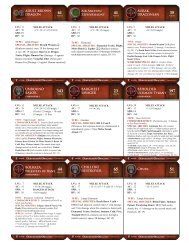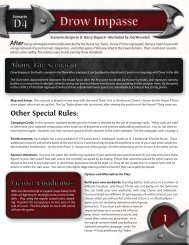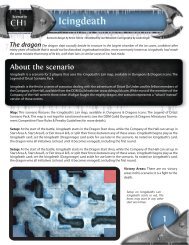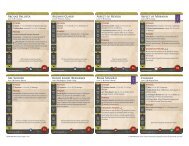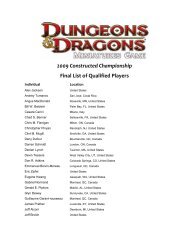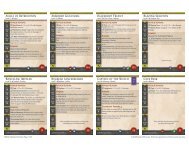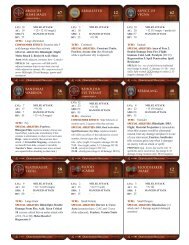You also want an ePaper? Increase the reach of your titles
YUMPU automatically turns print PDFs into web optimized ePapers that Google loves.
Cost<br />
The cost is the number of points you pay to add a creature to your warband. This is also the<br />
number used to determine victory points.<br />
Statistics<br />
This section provides information you need to play a battle.<br />
Level (Save): You add this number to a roll when the creature makes a save to avoid the<br />
effects of a spell or to resist running away.<br />
Speed: The number of squares the creature can move. A creature that does not attack or cast a<br />
spell can move up to twice its Speed.<br />
AC: (Armor Class) Any attack roll result against this creature that equals or exceeds this<br />
number is a hit and deals damage to the creature.<br />
HP: (Hit Points) When a creature’s HP total is reduced to 0, the creature is destroyed and<br />
removed from the battle map.<br />
Melee Attack: When attacking enemy creatures in adjacent squares (including diagonally),<br />
use the Melee Attack number. Roll a d20 (a 20-sided die) and add the number outside the<br />
parentheses. If the result equals or exceeds the enemy’s AC, the melee attack hits.<br />
Damage: The number inside the parentheses shows how much damage the creature deals with<br />
a successful melee attack.<br />
Additional Attacks: Some creatures can make more than one melee attack. The attack numbers<br />
are separated by a slash (/). In most cases, each attack deals the same amount of damage. If<br />
different attacks deal different damage, the damage numbers are listed in the same order as the<br />
attack numbers and are also separated by a slash.<br />
Ranged Attack: Use this number to attack enemies within line of sight (usually more than<br />
1 square away). Otherwise it works like a melee attack. Most creatures do not have a ranged<br />
attack.<br />
Type: The sort of creature it is. All creature types are listed in the glossary. This line may<br />
include one or more keywords separated by dashes that define the creature for the purpose of<br />
game effects. Sometimes a creature’s type includes characteristics that are important in play,<br />
and some special abilities or spells affect only certain creatures.<br />
If the creature is Tiny, Small, Large, or Huge, that information is also here. A creature with no<br />
size information is Medium.<br />
Commander Effect<br />
Commanders grant special bonuses to followers within 6 squares of them. Sometimes a<br />
commander effect targets enemy creatures. A few commander effects can influence other<br />
commanders in your warband, but these are the exception.<br />
Special Abilities<br />
These include the creature’s special attacks, resistances, and weaknesses (if any). When<br />
a specific special ability contradicts a general rule, that ability takes precedence. See the<br />
glossary at the end of this booklet for details on specific special abilities.<br />
Some special abilities can be used only a limited number of times. These have boxes ), ( one<br />
box for each use.<br />
Spells<br />
Some creatures can cast spells. Most spells can be used only a limited number of times. These<br />
have boxes (), one box for each use.<br />
5



